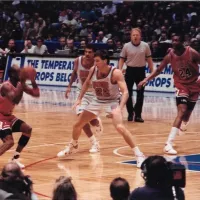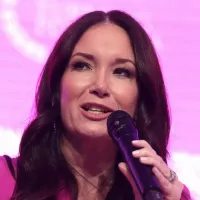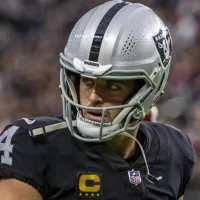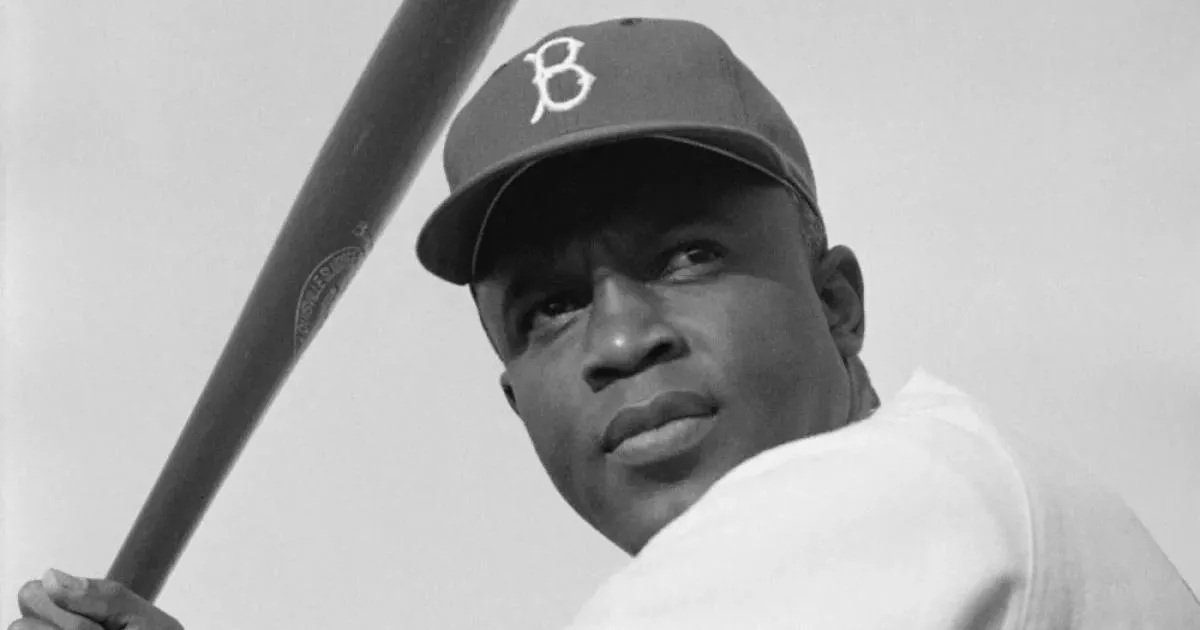Discover the career path of Jackie Robinson, from the first major opportunity to industry-changing achievements.
Jackie Robinson was an American professional baseball player who broke Major League Baseball's color barrier on April 15, 1947, when he started at first base for the Brooklyn Dodgers. His signing ended racial segregation in professional baseball, which had excluded Black players since the 1880s, relegating them to the Negro leagues. Robinson's courage and exceptional talent paved the way for greater racial equality in sports and beyond.
May 7, 1938: Broad-Jump Record
On May 7, 1938, Jackie Robinson broke an American junior college broad-jump record with a jump of 25 6+1⁄2 in. at Pasadena Junior College.
1939: Enrollment at UCLA
After graduating from PJC in spring 1939, Jackie Robinson enrolled at UCLA, where he became the school's first athlete to win varsity letters in four sports.
1939: Football Team
In 1939, Jackie Robinson was one of four black players on the Bruins' football team at UCLA, which was considered college football's most integrated team. They went undefeated with four ties at 6–0–4.
1940: NCAA Championship in Long Jump
In 1940, Jackie Robinson won the NCAA championship in the long jump at 24 ft 10+1⁄4 in (7.58 m).
1940: Left college for job
In the spring of 1940, Jackie Robinson left college just shy of graduation and took a job as an assistant athletic director with the government's National Youth Administration (NYA) in Atascadero, California.
1940: Led the NCAA in punt return average
Jackie Robinson led the NCAA in punt return average in the 1939 and 1940 seasons.
December 1941: Return to California
In December 1941, Jackie Robinson returned to California to pursue a career as running back for the Los Angeles Bulldogs of the Pacific Coast Football League after playing football for the Honolulu Bears. However, the Japanese attack on Pearl Harbor ended his nascent football career.
1942: Drafted into the Army
In 1942, Jackie Robinson was drafted and assigned to a segregated Army cavalry unit at Fort Riley, Kansas.
January 1943: Commissioned as Second Lieutenant
In January 1943, Jackie Robinson was commissioned as a second lieutenant after finishing Officer Candidate School (OCS) and got formally engaged to Rachel Isum.
August 1944: Acquittal
In August 1944, Jackie Robinson was acquitted by an all-white panel of nine officers on charges of insubordination during questioning.
November 1944: Honorable Discharge
In November 1944, Jackie Robinson received an honorable discharge from the Army and met a former player for the Kansas City Monarchs of the Negro American League, who encouraged Robinson to write to the Monarchs for a tryout.
1944: Athletic Director at Samuel Huston College
After his discharge in 1944, Jackie Robinson accepted a job as the athletic director at Samuel Huston College in Austin, which included coaching the school's basketball team for the 1944–45 season.
August 28, 1945: Branch Rickey Interviews Jackie Robinson
On August 28, 1945, Branch Rickey interviewed Jackie Robinson to assess his ability to withstand racial abuse without reacting angrily, a concern stemming from Robinson's previous confrontations with law enforcement. Rickey sought a player with the strength to "turn the other cheek" to racial antagonism, leading to a commitment from Robinson.
November 1, 1945: Rickey Commits to Formally Signing Robinson
Before November 1, 1945, Branch Rickey committed to formally signing Robinson to the Montreal Royals.
1945: Joins Kansas City Monarchs
In early 1945, Jackie Robinson accepted a contract to play professional baseball for the Kansas City Monarchs in the Negro leagues for $400 per month.
March 17, 1946: Jackie Robinson's Royals Debut
On March 17, 1946, Jackie Robinson made his debut for the Montreal Royals at Daytona Beach's City Island Ballpark in an exhibition game against the Dodgers, becoming the first black player to openly play for a minor league team against a major league team since the 1880s.
April 18, 1946: Jackie Robinson's Professional Debut
On April 18, 1946, Jackie Robinson made his professional debut with the Montreal Royals against the Jersey City Giants at Roosevelt Stadium, marking the first time the color barrier had been broken in a game between two minor league clubs. Robinson had four hits in five at bats, including a three-run home run, and stole two bases in the Royals' 14–1 victory.
1946: Robinson Arrives at Spring Training with the Montreal Royals
In 1946, Jackie Robinson arrived at Daytona Beach, Florida, for spring training with the Montreal Royals of the Class AAA International League, despite the Royals' manager Clay Hopper's request for him to be assigned elsewhere.
1946: Robinson Plays for Montreal Royals
In 1946, Jackie Robinson played for the Montreal Royals, residing at 8232 avenue de Gaspé near Jarry Park.
1946: Robinson Assigned to the Montreal Royals
In 1946, Jackie Robinson was assigned to the Montreal Royals, marking his entry into the International League as the first black baseball player since the 1880s, in what was later called "The Noble Experiment".
April 11, 1947: Jackie Robinson's Preseason Exhibition Game
On April 11, 1947, Jackie Robinson made his debut as a Dodger wearing uniform number 42 in a preseason exhibition game against the New York Yankees at Ebbets Field.
April 15, 1947: Jackie Robinson breaks the color line
On April 15, 1947, Jackie Robinson started at first base for the Brooklyn Dodgers, breaking the color line in Major League Baseball.
July 5, 1947: Larry Doby Breaks American League Color Barrier
On July 5, 1947, Larry Doby broke the color barrier in the American League, just 11 weeks after Jackie Robinson broke the color barrier in the National League.
1947: Beginning of Robinson's Career
In 1947, Jackie Robinson began his Major League Baseball career at the age of 28, playing for the Brooklyn Dodgers.
1947: Robinson Plays in the World Series
In 1947, Jackie Robinson played in all seven games of the World Series after the Brooklyn Dodgers won the National League pennant. The Dodgers lost in Game 7 to the Yankees, but Robinson became the first black player to play in the World Series.
1947: Rookie of the Year Award
In 1947, Jackie Robinson won the inaugural Rookie of the Year Award.
1947: Start of Balanced Offensive Strategies
Jackie Robinson's career, starting in 1947, is generally considered to mark the beginning of the post–"long ball" era in baseball, in which balanced offensive strategies using footspeed to create runs through aggressive baserunning replaced a reliance on raw power-hitting. From 1947 to 1953, Robinson averaged more than 110 runs per season.
1947: Robinson's Rookie Season
Jackie Robinson's rookie season ended in 1947.
February 1948: Robinson Signs Contract with Dodgers
In February 1948, Jackie Robinson signed a $12,500 contract with the Dodgers, while also engaging in a vaudeville tour and a speaking tour of the South during the off-season. He underwent surgery on his right ankle and reported to training camp overweight.
March 1948: Robinson Takes Over Second Base
In March 1948, after Stanky's trade to the Boston Braves, Jackie Robinson took over second base for the Dodgers.
August 1948: Dodgers Briefly Move into First Place
In late August 1948, the Dodgers briefly moved into first place in the National League but ultimately finished third.
August 29, 1948: Robinson Hits for the Cycle
On August 29, 1948, Jackie Robinson hit for the cycle in a 12–7 win against the St. Louis Cardinals, achieving a home run, a triple, a double, and a single in the same game.
1948: Batting average
In 1948, Jackie Robinson had a .296 batting average. This prompted him to seek batting help that resulted in improving his play in 1949.
1948: Truman's Military Desegregation
In 1948, President Harry Truman desegregated the military, contributing to increased equality for blacks alongside Jackie Robinson's breaking of the baseball color line.
1949: MVP Award and All-Star Selection
In 1949, Jackie Robinson significantly improved his batting with guidance from George Sisler, leading to a .342 average, 37 stolen bases, and being second in the league for doubles and triples. Due to this, Robinson earned the National League Most Valuable Player Award and was voted as the starting second baseman for the 1949 All-Star Game, the first to include black players.
1949: National League Most Valuable Player Award
In 1949, Jackie Robinson won the National League Most Valuable Player Award, the first black player to be so honored.
1950: Leads League in Double Plays and Film Biography Release
In 1950, Jackie Robinson led the National League in double plays made by a second baseman, with 133. Also in 1950, his salary was the highest any Dodger had been paid to that point, at $35,000. The film biography of Robinson's life, The Jackie Robinson Story, was released, with Robinson playing himself.
1950: League Leader in Fielding
In 1950, Jackie Robinson led the league in fielding among second basemen.
October 3, 1951: Dodgers Lose Pennant
On October 3, 1951, the Dodgers lost the pennant after Bobby Thomson's famous home run, known as the Shot Heard 'Round the World. Jackie Robinson ensured Thomson touched all the bases, finishing the season with 106 runs scored, a .335 batting average, and 25 stolen bases.
1951: Offer to Manage Montreal Royals
Before the 1951 season, Walter O'Malley reportedly offered Jackie Robinson the job of manager of the Montreal Royals, to be effective at the end of Robinson's playing career, although reports differed as to whether a position was ever formally offered.
1951: League Leader in Double Plays and Pennant Contention
During the 1951 season, Jackie Robinson led the National League in double plays made by a second baseman for the second year in a row, with 137. He also kept the Dodgers in contention for the 1951 pennant, hitting a game-tying hit in the 13th inning and a game-winning home run in the 14th inning of the last game of the regular season. This forced a playoff series against the New York Giants.
1951: League Leader in Fielding
In 1951, Jackie Robinson led the league in fielding among second basemen for the second consecutive year.
1952: Challenging Racial Record
In 1952, Jackie Robinson finished the year with 104 runs, a .308 batting average, and 24 stolen bases. He recorded a career-high on-base percentage of .436. The Dodgers won the National League pennant before losing the 1952 World Series to the New York Yankees in seven games. On the television show Youth Wants to Know, Robinson challenged the Yankees' general manager, George Weiss, on the racial record of his team.
1953: Death Threats and Racial Advocacy
In 1953, Jackie Robinson had 109 runs, a .329 batting average, and 17 steals, leading the Dodgers to another National League pennant. He also served as editor for Our Sports magazine and criticized segregated establishments, leading to integration in some places. However, Robinson's continued success spawned a string of death threats.
1954: All-Star Season
From 1949 through 1954, Jackie Robinson was an All-Star for six consecutive seasons.
1954: Best Day at the Plate
In 1954, Jackie Robinson had 62 runs scored, a .311 batting average, and 7 steals. His best day at the plate was on June 17, when he hit two home runs and two doubles.
1955: World Series Championship
In 1955, Jackie Robinson contributed to the Dodgers' World Series championship.
1955: World Series Victory and Declining Performance
In 1955, the Dodgers defeated the New York Yankees in the World Series, marking Jackie Robinson's only championship. However, 1955 was the worst year of Robinson's individual career, hitting .256 and stealing only 12 bases, and he did not play in Game 7 of the World Series.
1956: Final Season and Retirement Decision
In 1956, Jackie Robinson had 61 runs scored, a .275 batting average, and 12 steals. After striking out to end Game 7 of the 1956 World Series, he was traded to the New York Giants, but the trade was never completed because Robinson had agreed to become an executive with Chock full o'Nuts and sold exclusive rights to his retirement story to Look magazine.
1956: End of Robinson's Career
The 1956 season marked the end of Jackie Robinson's 10-season career in Major League Baseball, all with the Brooklyn Dodgers.
January 5, 1957: Robinson's Retirement
Jackie Robinson retired from baseball at age 37 on January 5, 1957.
1957: Vice President at Chock full o'Nuts & Chairs NAACP Freedom Fund Drive
In 1957, Jackie Robinson became the vice president for personnel at Chock full o'Nuts, becoming the first black person to serve as vice president of a major American corporation. Also in 1957, he chaired the NAACP's million-dollar Freedom Fund Drive.
October 1959: Robinson Protests Segregation at Greenville Airport
In October 1959, Jackie Robinson protested racial segregation by entering the whites-only waiting room at Greenville Municipal Airport, refusing to leave when asked by airport police. He then delivered a speech to the NAACP in Greenville, South Carolina, advocating for complete freedom and urging black citizens to vote and protest their second-class citizenship.
1960: Supports Richard Nixon for President
In the 1960 presidential race, Jackie Robinson supported Richard Nixon against John F. Kennedy, later praising Kennedy for his stance on civil rights.
1962: Elected to Baseball Hall of Fame
In 1962, Jackie Robinson was elected to the Baseball Hall of Fame in his first year of eligibility. He encouraged voters to consider only his on-field qualifications, rather than his cultural impact on the game, becoming the first black player inducted into the Cooperstown museum.
1964: Founds Freedom National Bank
In 1964, Jackie Robinson helped found Freedom National Bank with Harlem businessman Dunbar McLaurin. This bank was a black-owned and operated commercial bank based in Harlem.
1964: Opposes Barry Goldwater's Presidential Candidacy
In 1964, Jackie Robinson was angered by the presidential election candidacy of conservative Republican Senator Barry Goldwater of Arizona, who had opposed the Civil Rights Act of 1964.
1965: Becomes Analyst for ABC's Major League Baseball Game of the Week
In 1965, Jackie Robinson became an analyst for ABC's Major League Baseball Game of the Week telecasts, making him the first black person to hold such a position.
1966: Special Assistant for Community Affairs
In 1966, Jackie Robinson became special assistant for community affairs when Nelson Rockefeller was re-elected governor of New York.
1966: Hired as General Manager for Brooklyn Dodgers of Continental Football League
In 1966, Jackie Robinson was hired as the general manager for the short-lived Brooklyn Dodgers of the Continental Football League.
1967: Leaves NAACP Board
In 1967, Jackie Robinson ended his service on the board of the NAACP.
1968: Supports Hubert Humphrey for President
In 1968, Jackie Robinson broke with the Republican party and supported Hubert Humphrey against Richard Nixon in that year's presidential election.
1970: Establishes Jackie Robinson Construction Company
In 1970, Jackie Robinson established the Jackie Robinson Construction Company to build housing for low-income families.
1971: Appointed to New York State Athletic Commission
In 1971, Jackie Robinson was appointed to the New York State Athletic Commission by Nelson Rockefeller.
June 4, 1972: Dodgers Retire Robinson's Uniform Number
On June 4, 1972, the Dodgers retired Jackie Robinson's uniform number, 42, alongside those of former teammates Roy Campanella (39) and Sandy Koufax (32).
October 15, 1972: Final Public Appearance at World Series
On October 15, 1972, Jackie Robinson made his final public appearance at Riverfront Stadium in Cincinnati, throwing the ceremonial first pitch before Game 2 of the World Series. He accepted a plaque honoring the twenty-fifth anniversary of his MLB debut but expressed his desire to see a black manager in baseball.
1972: Part-Time Commentator for Montreal Expos Telecasts
In 1972, Jackie Robinson served as a part-time commentator on Montreal Expos telecasts.
1984: Charter Member of UCLA's Athletics Hall of Fame
In 1984, Jackie Robinson was among the 25 charter members of UCLA's Athletics Hall of Fame.
1997: Bronze Sculpture Erected in Pasadena
In 1997, a $325,000 bronze sculpture by artists Ralph Helmick, Stu Schecter, and John Outterbridge depicting oversized nine-foot busts of Robinson and his brother Mack was erected at Garfield Avenue in Pasadena.
Mentioned in this timeline

Basketball is a team sport played on a rectangular court...

John F Kennedy JFK was the th U S President...

Bill Russell was a dominant American professional basketball player primarily...

George W Bush the rd U S President - is...

Wayne Gretzky a Canadian former professional ice hockey player widely...
California is a U S state on the Pacific Coast...
Trending
1 month ago World Cup 2026 Draw: Brazil in Group C, France's Path
2 months ago India-Bangladesh Ties Strained as Hasina Faces Potential Execution; Extradition Unlikely.
2 months ago DHS immigration crackdown hits Charlotte, sparking protests and local confusion.

2 months ago Brooke Rollins' SNAP Benefits Criticism Sparks Controversy; Johnson Intervenes After 'Failed You' Comment.

3 months ago Marjorie Taylor Greene breaks with GOP on Obamacare, citing disgust over potential premium hikes.

8 months ago Derek Carr's Retirement Announcement and Injury Concerns in New Orleans Saints Saga
Popular

Stranger Things created by the Duffer Brothers is a popular...

XXXTentacion born Jahseh Dwayne Ricardo Onfroy was a controversial yet...

Kelsey Grammer is an accomplished American actor producer and singer...

Candace Owens is an American conservative political commentator and author...

Bernie Sanders is a prominent American politician currently serving as...

Melania Trump a Slovenian-American former model has served as First...

